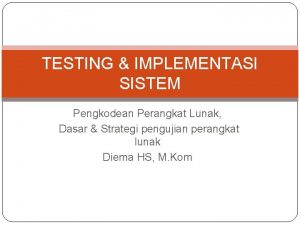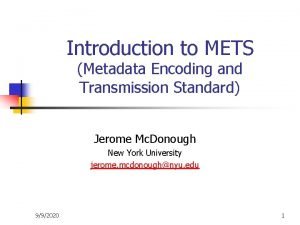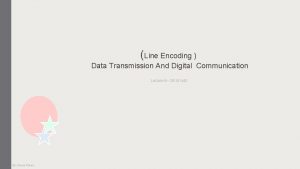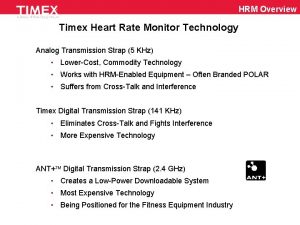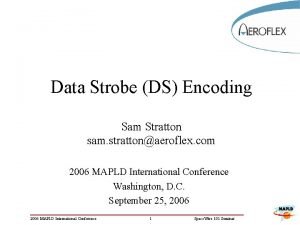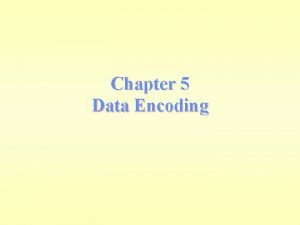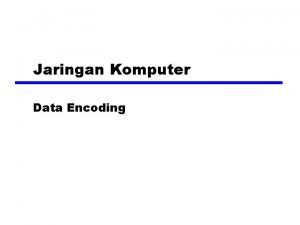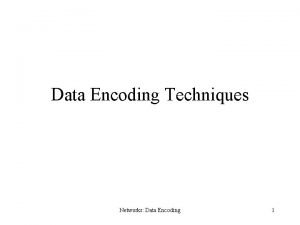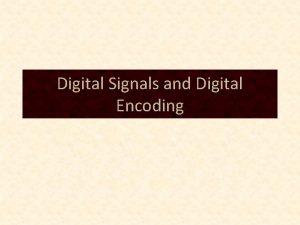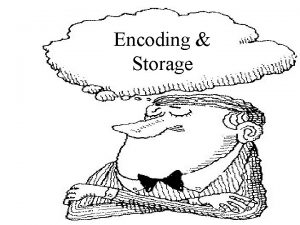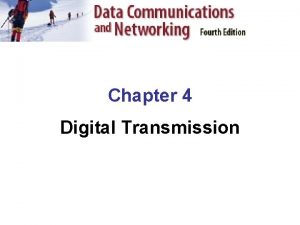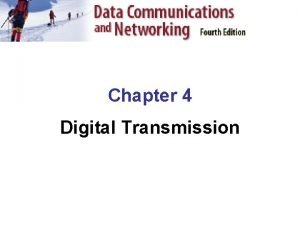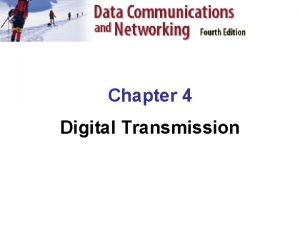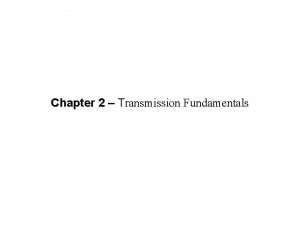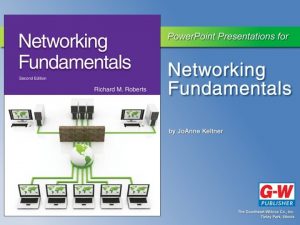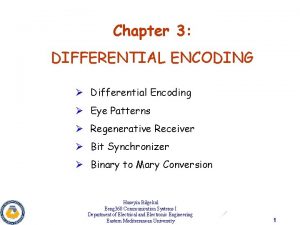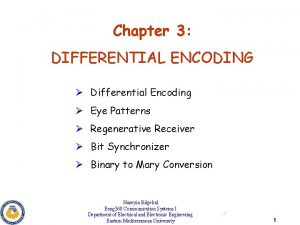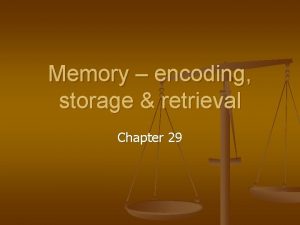Chapter 5 Data Encoding Data Transmission Digital data
















- Slides: 16

Chapter 5 Data Encoding Data Transmission • Digital data, digital signal • Analog data, digital signal: e. g. , voice, and video are often digitized to use digital transmission facilities. (e. g. PCM) • Digital data, analog signal: for trans. media (e. g. optical fiber, unguided media) only propagate analog signal. (e. g. ASK, FSK, PSK) • Analog data, analog signal: to shift the bandwidth of baseband signal into another portion of spectrum. 10/31/2020 Spring, 2003 EE 4272

Digital Data, Digital Signal • Digital signal: Discrete, discontinuous voltage pulses; each pulse is a signal element; Binary data encoded into signal elements Ø Unipolar: All signal elements have same sign Ø Polar: One logic state represented by positive voltage the other by negative voltage • Data rate: Rate of data transmission in bits per second (bps) • Duration or length of a bit: Time taken for transmitter to emit the bit • Modulation rate: Rate at which the signal level changes Ø Measured in baud = signal elements/sec (e. g. pulse/sec) 10/31/2020 Spring, 2003 EE 4272

Performance Metrics of Encoding Schemes • Signal Spectrum Lack of high frequencies reduces required bandwidth Ø Lack of dc component allows ac coupling via transformer, providing isolation Ø Good scheme concentrate power in the middle of the bandwidth Ø • Clocking: Synchronizing transmitter and receiver External clock Ø Sync mechanism based on signal Ø • Error detection: Can be built in to signal encoding • Signal interference and noise immunity: Some codes are better than others • Cost and complexity Higher signal rate (& thus data rate) lead to higher costs Ø Some codes require signal rate greater than data rate Ø 10/31/2020 Spring, 2003 EE 4272

DDDS Encoding Schemes • Nonreturn to Zero (NRZ): Nonreturn to Zero-Level (NRZ-L) Ø Nonreturn to Zero Inverted (NRZI) Ø • Multilevel Binary: (reading assignment) Bipolar –AMI (Alternate Mark Inversion) Ø Pseudoternary Ø • Biphase: Manchester Ø Differential Manchester Ø • Scrambling Techniques: (reading assignment) B 8 ZS Ø HDB 3 Ø 10/31/2020 Spring, 2003 EE 4272

Nonreturn to Zero-Level (NRZ-L) • Two different voltages for 0 and 1 bits • Voltage constant during bit interval Ø no transition i. e. no return to zero voltage • e. g. Absence of voltage for zero, constant positive voltage for one • More often, negative voltage for one value and positive for the other Bits 0 0 1 1 1 1 0 0 0 0 1 0 NRZ-L Clock Manchester NRZI 10/31/2020 Spring, 2003 EE 4272

Nonreturn to Zero Inverted • Constant voltage pulse for duration of bit • Data encoded as presence or absence of signal transition at the beginning of bit time • Transition (low to high or high to low) denotes a binary 1 • No transition denotes binary 0 • An example of differential encoding 10/31/2020 Spring, 2003 EE 4272

NRZ pros and cons • Pros: Easy to engineer; Make good use of bandwidth • Cons: Lack of synchronization capability (e. g. successive 0 s) • Used for magnetic recording • Not often used for signal transmission -> Differential Encoding • Data represented by changes rather than levels • More reliable detection of transition rather than level • e. g. , Manchester Code 10/31/2020 Spring, 2003 EE 4272

Biphase Coding • Manchester Ø Ø Ø Transition in middle of each bit period Transition serves as clock and data Low to high represents one High to low represents zero -> XOR of clock and NRZL Used by IEEE 802. 3 (for baseband coaxil cable & twisted-pair CSMA/CD bus LANs) • Differential Manchester Ø Ø Ø Midbit transition is clocking only Transition at start of a bit period represents zero No transition at start of a bit period represents one Note: this is a differential encoding scheme Used by IEEE 802. 5 (token ring LAN) 10/31/2020 Spring, 2003 EE 4272

Biphase Pros and Cons • Con At least one transition per bit time and possibly two Ø Maximum modulation rate is twice of NRZ Ø Requires more bandwidth Ø • Pros Synchronization on mid bit transition (self clocking) Ø Error detection: Absence of expected transition Ø 10/31/2020 Spring, 2003 EE 4272

Digital Data, Analog Signal • Use Public telephone system: 300 Hz to 3400 Hz Ø Use modem (modulator-demodulator) • Amplitude shift keying (ASK): Values represented by different amplitudes of carrier Ø Usually, one amplitude is zero, i. e. presence and absence of carrier is used Ø Used over optical fiber Ø • Frequency shift keying (FSK) Ø Values represented by different frequencies (near carrier) Used for high frequency radio trans. (3 to 30 MHZ) Ø Even used for higher frequency on LANs using co-ax Ø • Phase shift keying (PK) Ø Phase of carrier signal is shifted to represent data 10/31/2020 Spring, 2003 EE 4272

Modulation Techniques 10/31/2020 Spring, 2003 EE 4272

Analog Data, Digital Signal • Digitization Conversion of analog data into digital data Ø Digital data can then be transmitted using NRZ-L Ø Digital data can then be transmitted using code other than NRZ-L Ø Digital data can then be converted to analog signal Ø Analog to digital conversion done using a codec Ø Ø Pulse code modulation Ø Delta modulation 10/31/2020 Spring, 2003 EE 4272

Pulse Code Modulation (PCM) • If a signal is sampled at regular intervals at a rate higher than twice the highest signal frequency, the samples contain all the information of the original signal (Sampling Theory) • Voice data limited to below 4000 Hz • Require 8000 sample per second • Each sample assigned digital value • 4 bit system gives 16 levels • Quantized • 8 bit sample gives 256 levels • Quality comparable with analog transmission • 8000 samples per second of 8 bits each gives 64 kbps 10/31/2020 Spring, 2003 EE 4272

Analog Data, Analog Signals • Why modulate analog signals? Higher frequency can give more efficient transmission Ø Permits frequency division multiplexing (chapter 8) Ø • Types of modulation Amplitude Ø Frequency Ø Phase Ø 10/31/2020 Spring, 2003 EE 4272

Analog Modulation 10/31/2020 Spring, 2003 EE 4272

Spread Spectrum • • • Analog or digital data Using analog signal Spread data over wide bandwidth Makes jamming and interception harder Frequency hoping Ø Signal broadcast over seemingly random series of frequencies • Direct Sequence Each bit is represented by multiple bits in transmitted signal Ø Chipping code Ø 10/31/2020 Spring, 2003 EE 4272
 Digital encoding schemes
Digital encoding schemes Basic coding test
Basic coding test Digital data digital signals
Digital data digital signals Metadata encoding and transmission standard
Metadata encoding and transmission standard Encoding in digital communication
Encoding in digital communication Digital to analog encoding
Digital to analog encoding Timex heart rate monitor strap
Timex heart rate monitor strap Calculate quantization error
Calculate quantization error Digital vs analog transmission
Digital vs analog transmission Analogue and digital transmission in computer networks
Analogue and digital transmission in computer networks Data strobe encoding
Data strobe encoding Encoding data
Encoding data Data encoding
Data encoding Data encoding techniques
Data encoding techniques Digital data digital signals
Digital data digital signals Puncture resistant container
Puncture resistant container Chapter 19 disease transmission and infection prevention
Chapter 19 disease transmission and infection prevention

